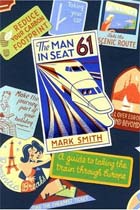You will pay the price for your lack of vision
As is often the case, something comes up that I latch on to. So, last post about High Speed 2 for a while I promise. I read some of HS2’s final report yesterday, looking over the evidence that went in to the government’s white paper. As I suspected, they are going down the mini-shinkansen route as regards connecting the high speed line to the rest of the network – rather than one type of train that will fit the British loading gauge, there will be two types, which they describe as “captive” (i.e. restricted to High Speed 2 itself) and “classic compatible” (capable of operating on the existing network). However, two things strike me:
- There is still continuing talk of fully 400m long trains, with no regard to this being achieved through pairs of coupled units, but rather as one long train.
- There is a specific reference that the “classic compatible” trains WILL NOT TILT
I’ll discuss the second part in detail in a moment. First off, most high speed networks do not operate full length 400m trains like the Class 373s of Eurostar. Most instead are usually half this length and can operate singly or in pairs to increase length, and thus capacity. Indeed, this is how the mini-shinkansen operates, with an ordinary Shinkansen set coupled to a Mini-Shinkansen set, and this long train splitting and carrying on to two destinations. However, we’ll set that aside, as it is a service provision which would not be an issue for more than a decade. It is the second item that I think is the more important to focus on. In the report, HS2 state that the “classic compatible” trains will not be fitted to tilt, as the current Class 390 units used on the West Coast Main Line do. It is because they tilt that they can achieve the speeds that they do, up to 125mph. HS2 claim that the time that is made up on the high speed line would make up for time lost by reducing speeds on the existing network, which would result from the trains not being able to tilt. This is without question a step backwards and should not be countenanced. You might as well go back to using Class 86 and 87 locomotives on the WCML. For the wont of a tilt mechanism, the time taken to get to Glasgow or Edinburgh via High Speed 2 could be slashed to barely three hours. THREE HOURS!! Not only would this be important in linking the two major Scottish cities to London, but it could potentially prove that extending high speed rail to Scotland is economically sound. It isn’t even as though it would be potentially difficult to achieve. While it may not be possible to have a tilting train run at 300km/h, by developing the “classic compatible” and “captive” trains together, you could create a push-pull configuration where the “captive” set powers the traction of the whole train while on the high speed line at 300km/h (meaning that the “classic compatible” set would only need to not fall apart at that speed), with the other set running at 225km/h on the ordinary network. Let’s play pretend:
The train at Platform 1 will be the 10:00 service to Birmingham Curzon Street and Glasgow Central, calling at Old Oak Common, Birmingham Interchange and Birmingham Curzon Street, where the train divides. Join the rear eight coaches for Stafford, Stockport, Manchester Piccadilly, Preston, Carlisle and Glasgow Central
So there we have our train to Glasgow, formed of one “captive” set that pulls the train as far as Birmingham and one “classic compatible” set coupled to the rear, which then carries on to Glasgow. What about the way back?
The train at Platform 1 will be the 15:00 service to Birmingham Curzon Street, calling at Carlisle, Preston, Manchester Piccadilly, Stockport, Stafford and Birmingham Curzon Street.
So our train from Glasgow pulls into Birmingham and couples together with a waiting high speed train to London. Now though it is the Glasgow section that is on the front. No problem, because this is a push-pull train, and all the power comes from the unit at the back – although the train is controlled from the front, the tractive effort comes from the unit on the rear; it is being pushed to 300km/h all the way to London. And it is this that should be the consideration when thinking about the trains to be used. Because these would then also be the trains used on the existing West Coast Main Line for those services not transferred to High Speed 2. The report from HS2 is too conservative in its choices of rolling stock, which goes hand in hand with the upgrading of signalling to allow 225km/h running on the WCML.















I like the playing pretend thing! 🙂
Do trains split like that these days? I thought that was a thing of the past. I can see how it would be a good idea here (assuming I have understood all this correcrtly) as it would seem to answer two problems.
Even now trains do split to run to multiple destinations. The mini-shinkansen example is the most obvious comparison in this case, but even here you have trains splitting midway through the journey.
[…] Posted in Great Britain, High Speed, Rolling stock by Chairman Pip on April 29, 2010 I spoke some time ago about the proposals given in HS2 Ltd’s report regarding rolling stock and that, given that […]